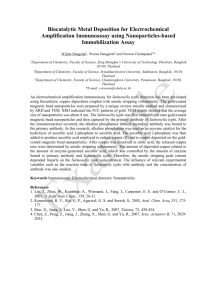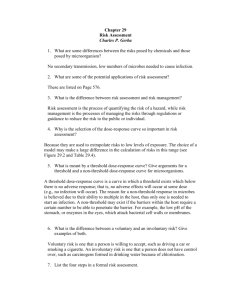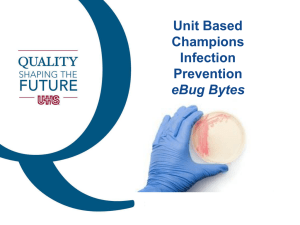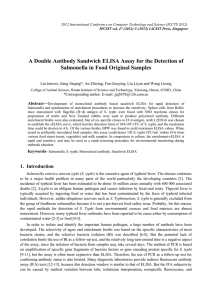Atypical presentation of Salmonella Typhi infection Dear Editor
advertisement
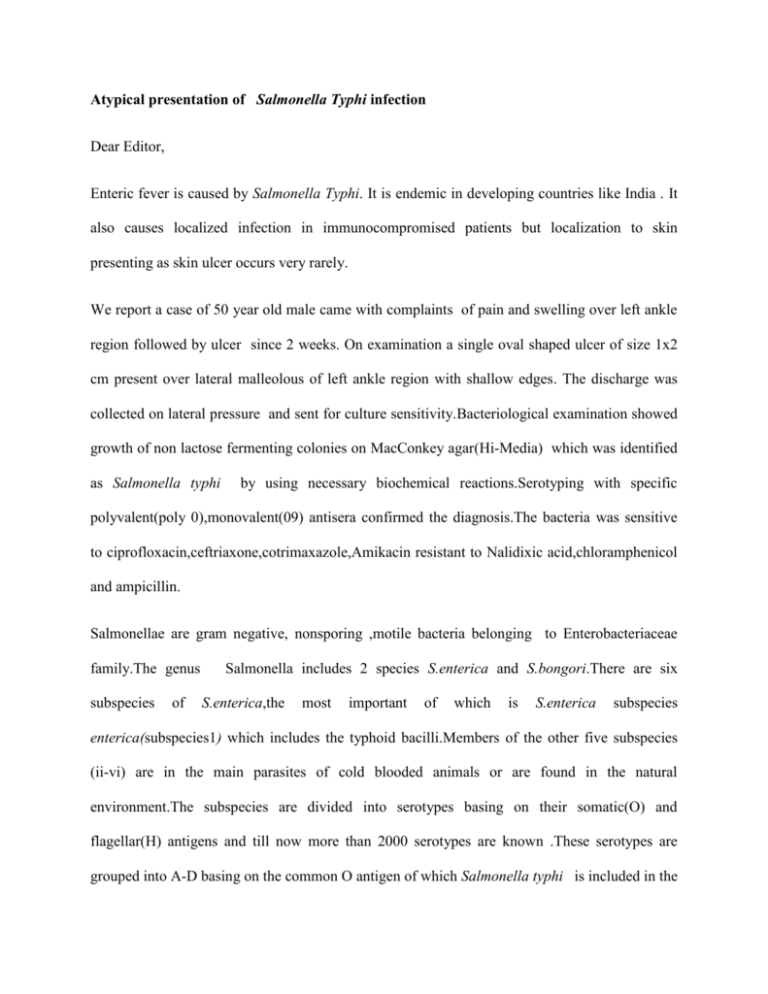
Atypical presentation of Salmonella Typhi infection Dear Editor, Enteric fever is caused by Salmonella Typhi. It is endemic in developing countries like India . It also causes localized infection in immunocompromised patients but localization to skin presenting as skin ulcer occurs very rarely. We report a case of 50 year old male came with complaints of pain and swelling over left ankle region followed by ulcer since 2 weeks. On examination a single oval shaped ulcer of size 1x2 cm present over lateral malleolous of left ankle region with shallow edges. The discharge was collected on lateral pressure and sent for culture sensitivity.Bacteriological examination showed growth of non lactose fermenting colonies on MacConkey agar(Hi-Media) which was identified as Salmonella typhi by using necessary biochemical reactions.Serotyping with specific polyvalent(poly 0),monovalent(09) antisera confirmed the diagnosis.The bacteria was sensitive to ciprofloxacin,ceftriaxone,cotrimaxazole,Amikacin resistant to Nalidixic acid,chloramphenicol and ampicillin. Salmonellae are gram negative, nonsporing ,motile bacteria belonging to Enterobacteriaceae family.The genus subspecies of Salmonella includes 2 species S.enterica and S.bongori.There are six S.enterica,the most important of which is S.enterica subspecies enterica(subspecies1) which includes the typhoid bacilli.Members of the other five subspecies (ii-vi) are in the main parasites of cold blooded animals or are found in the natural environment.The subspecies are divided into serotypes basing on their somatic(O) and flagellar(H) antigens and till now more than 2000 serotypes are known .These serotypes are grouped into A-D basing on the common O antigen of which Salmonella typhi is included in the group D.(1)The infection is usually initiated by ingestion of sufficient organisms to colonize the gut and express the mechanisms resulting in clinical disease.Once it attaches to the host intestinal mucosa there will be degeneration of microvilli through which salmonella enters the intestinal epithelial cells.Some bacteria may penetrate into the submucosa and pass to the local mesenteric lymphnodes.After ileal penetration the symptoms of diarrhea begins.For strains of Salmonella typhi infection involves the invasion of the blood stream and various organs.(2) Although it can cause a wide spectrum of clinical illness there are four major syndromes namely entericfever, gastroenteritis, bacteraemia with or without metastatic infection and the symptomatic carrier state.Transient bacteraemia occurs in 4% of cases of enteric fever due to Salmonella typhi but in most cases the organisms are cleared from the blood. It can be isolated from the blood in about 90% of patients during the first week and from 50% of patients at the end of third week.It may also be isolated from faeces and urine through out the illness. But in rare cases dissemination to different sites of body where pre existing abnormality is seen in tissue or organ causing localized infection commonly seen in immunocompromised patients.But localization to skin presenting as skin ulcer occurs very rarely.But in our case the cutaneous ulceration is the only manifestation of infection in an immunocompetant individual.Source of the infection cannot be traced out.He is a agricultural field worker by profession,so the source of infection could have been material contaminated with Salmonella typhi or infection by trauma induced skin lesion. Only few cases of skin manifestations caused by Salmonella typhi have been reported.(3)It rarely causes soft tissue infections at the sites of local trauma(4). Localised infection due to it have been described in bones &joints, intraperitoneal, splenic, breast and subcutaneous regions(5).The patient was treated with ciprofloxacin 500mg BD for 15 days with complete cure.Cultures performed after healing failed to grow any organism.To conclude in endemic countries like India the atypical presentations due to Salmonella Typhi should be kept in mind so that there is no delay in treating the patient. REFERENCES: 1. Old DC,Threl fall EJ. Salmonella.In :Balows A,Duerden BI eds.Topley and Wilson’s Microbiology&Microbial infections.1998;969-997. 2. Green Wood D,Slack RCB,Peutherer JF eds.Chart H,Salmonella.In :Medical Microbiology 2008;250-259. 3. Thakur K,Singh G,Gupta P,Chauhan S,Jaryal SC.Primary anterior parietal wall abscess due to Salmonella Typhi. Braz J InfectDis 2010; 14(4):328-329. 4.Raghunath R,Ashok AC,Sridaran D,Indumathi VA,Belwadi MR.Acase of injection abscess due to Salmonella Typhi.Indian J Med Microbiol 2003;21:59-60. 5. Marzano AV ,Mercogliano M, Borghi A, Facchetti M,Caputo R.Cutaneous infection caused by Salmonella Typhi.European Academy of Dermatology and VenereologyJEADV (2003) 17,575-77.



